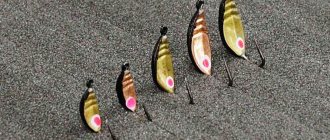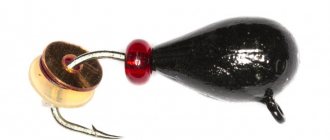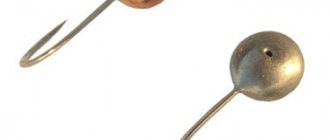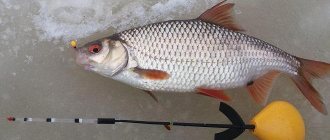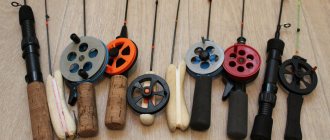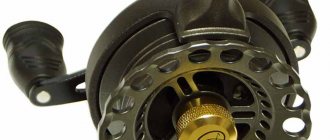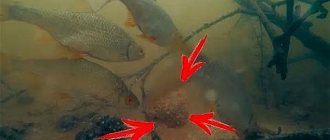It is traditionally believed that lazy, clumsy bream in winter indifferently lets through a bait that moves too actively. In this regard, most anglers catch this fish with bait on fixedly installed float or nod fishing rods. True, there are enthusiasts who are always on the lookout, constantly moving across the ice of a reservoir, looking for places where bream camps, but in the vast majority of cases they also fish with a jig with the addition of bloodworms. And only a very small category of fishermen practice catching bream with a reelless reel in winter. Very often these innovators come up with a good catch at a time when it seems that the fish are not feeding at all.
Catching bream with a reelless reel in winter
It is quite difficult to explain this relationship between bream and an oscillating jig. Obviously, during periods of low activity, the fish watches the bait for a long time before touching it with its lips. It detects the discrepancy between the vibrations of the bloodworm on the jig and the natural movements of the larva and moves away from it. In the case of a baitless jig, bream and other fish, not seeing the discrepancy between the artificial and the living, react only to the vibrations created by the jig, which it picks up with all sensory organs.
In general, deciding to switch to catching bream with a baitless jig is quite difficult. Many people, having started to master it, quickly lose interest in it, since finding the right game is not so easy. If the bream and white bream do not find themselves biting at all (and they do not take any bait), then the beginner, having caught a little with a nozzle jig, quickly returns to the jig with the addition of bloodworms - after all, this is a proven method. Practice shows that no more than 7 percent of the entire army of fishermen catch fish with a baitless jig.
In order to consistently catch bream and bream using a baitless jig, you should carefully select all the elements of the equipment and balance them properly. It is equally important to improve your skills: correct playing technique is the basis for success. Searching for catchable places also plays an important role. Let's start in order.
Fishing without bait
Jigs used without bait are called reelless jigs . Catching bream in winter using a reelless bait requires more experience and skill in the game, so few people use this method. In fact, when fishing in the current or at shallow depths, fishing with a reelless bait can be even better than classic gear. Playing in the stream, a small jig imitates the movements of live bait and the fish, focusing on the vibrations, falls for it.
The practice and experience of fishermen shows that it is better to choose large jigs without moths, this will reduce the percentage of fish hatching. But you should not overdo it: too much bait can scare away the bream.
Winter tackle for bream
Rigging a winter fishing rod for bream
Rod
For a novice fisherman, the best choice is a fishing rod 40–45 cm long with a comfortable (preferably cork) handle (5 to 15 cm long) and an open or closed reel with a spool diameter of 4.5–6 cm. The reel brake can be blind or frictional. The latter is much more convenient when fishing at various depths, especially in relatively shallow water, where bream can go during a thaw.
The whip is set 20–30 cm long. In general, the type of fishing rod is determined by the wiring technique and fishing conditions. Some successfully fish with a balalaika, others use homemade models, others prefer branded Finnish fishing rods.
Nod
This is one of the most important equipment elements. It can be made from various materials. The best choice for catching bream with a no-attachment jig is a conical nod made from a clock spring; You can use propylene, polycarbonate, Mylar tape or other soft material.
The length of the nod can reach 18 cm. Such dimensions allow you to achieve stable play and even out unnecessary, unexpected movements of the hand. When using small jigs in shallow water, the length of the nod is maximized.
Shortened nods are used in windy weather and when fishing at a depth of over 5 meters. Under various fishing conditions, short nods made from a gramophone plate work well. The nod must have an end hole or ring for passing the fishing line. On long nods, in order to prevent sagging of the line, crimp cambrics are installed or an additional hole is made in the middle of the nod.
Fishing line for bream in winter
It is best to use soft modifications with a diameter of 0.1–0.15 mm such as “TEKLON” (Japan) or “SILYER FISH” (Germany).
These lines, having increased knot strength and a very smooth surface, are less susceptible to tangling when fishing near frozen ice chips. For fishing at depths of more than 7 m, hard fishing lines are used. This is due to the fact that a rigid line sinks faster, gets tangled less when landing fish and transmits a bite more clearly. We can recommend sinking fishing lines.
This is interesting: Selecting a high-quality ice screw
The quality of the game depends on how thin the fishing line is. However, it should be borne in mind that large bream should not be caught on fishing lines with a diameter of less than 0.1 mm, since there will inevitably be breaks.
It makes no sense to use thinner but stronger “braids” in winter conditions only because they will freeze even in mild frost.
Jig for bream in winter
For reelless fishing for bream, most anglers use “devils”. This type of jig came into fashion in the seventies of the last century. There are many modifications of these baits, they are sometimes very different from each other, their appearance is largely determined by the imagination of the manufacturer.
“Devils” may vary in body shape, method of attaching hooks and fishing line, shape of hooks, method of adding beads or other artificial additions, etc. Wiring options may also vary depending on the model.
The most common “devil” has a triple hook, but even four-hook models are often used. Some experimenters use two “devils” at once. This is due to the possibility of provoking the fish to intercept, because with two baits it appears that one aquatic organism is chasing another.
Practice has shown that with a good bite, it is preferable to use a large “devil”, which can reduce the percentage of large fish hatching. It is known that ovoid “devils” are less hooky than elongated ones. Recently, “devils”, which are made in the form of segmental joints, have become popular.
This is interesting: You can drill with a screwdriver
The choice of bait color is usually determined by its similarity with the colors of aquatic invertebrates. The most commonly used colors are black, gray, and dark brown. Depending on the characteristics of the reservoir, lighting and other fishing conditions, sometimes yellowish, greenish baits or those that have a combined color are used. But there are exceptions in the form of burgundy and other colors.
In case of fishing at great depths, of course, heavy tungsten “devils” with sharply sharpened hooks will be preferable. Their color may be somewhat lighter than that of baits used in shallow water, where it is best to use jigs of a dark, matte, black-brown color.
The option of an elongated nozzle jig with hooks soldered into a lead or tungsten body is considered optimal. There is also a hook attachment on a movable suspension. The size of hooks for catching bream is No. 10–13, for bream – No. 13–18.
Not so long ago, fishermen came up with the idea of using all sorts of artificial additives in combination with a baitless jig. The question arises: what to take as a bait for the “devil” intended for catching bream? Just as there are many artificial materials, there are also many options for their fastening or installation. Beads, seed beads, polystyrene foam, foam rubber, elastic band, thread. It’s impossible to list everything, but there are some generally accepted options for artificial attachments that give good results. The most popular among fishermen are beads that move freely on the hook.
Read also: Catch bream on a river or reservoir in winter?!
The combination of white and yellow beads attracts large bream well. Sometimes it is enough to put a yellow or ivory bead on the hook. You can attach a tiny piece of dirty red or yellow foam rubber to one hook. A combination of white and yellow cambric is also suitable. It should be remembered that the combination of white and red colors attracts perch, and if you put a white foam ball on the hook, then there may be no end to the bleak.
Sometimes when fishing for bream and bream, a positive result is obtained by putting one or two yellow beads (beads) directly on the fishing line, which, when reeled, tap against each other and against the body of the bait. The acoustic signals produced in this case apparently remind bream of the sounds emanating from small aquatic organisms at the moment when they are actively moving.
Continuing the conversation about the no-attach jig for bream, we note that in addition to “devils”, fishermen widely use single-hook “nymphs”, “uralkas”, “ants” and double-hook “goats”. These jigs are also most often used in combination with beads placed on a hook.
It is the beads that, with certain vibrations of the nod, create a unique effect of a vibration field, which the fish perceives as a signal to start feeding.
In general, a nozzle-free jig can be positioned in relation to the fishing line either vertically or at an angle of 120 degrees. The location of the jig is largely determined by its modification and the method of fixing the fishing line (Fig. 125).
Like “devils,” some models of jigs may have a hinged connection between the hook and the body of the bait, which helps create additional non-standard vibrations. This brings success when fishing in those reservoirs that experience strong fishing pressure. Of course, here too there should be some artificial addition on the hook in the form of colored beads, tiny cambrics, foam particles, etc.
As for the color of the hooks, practice has proven that in any lighting conditions, wary bream are more bold in taking the bait from a dark rather than a light hook. For baitless fishing, you need to take hooks with a shallower hook, which is well camouflaged with beads or other artificial bait.
Technique for catching bream using a reelless reel
There are general principles of the game that you should pay attention to. The main thing in the game is to make the jig only vibrate, practically remaining in place. At the same time, it is permissible to carry out a measured rise of the bait from the bottom by 30 cm - 40 cm - 50 cm - up to 1 m.
The vibration of the jig is achieved by methodically constantly rocking the fishing rod with a significant frequency and small amplitude of the nod oscillations. If the oscillations of its tip are not close to zero and there are also glitches in the game, this does not attract, but rather scares away the fish.
They begin wiring after the bait sinks to the bottom. After tapping the jig on the ground several times, they begin its subtle rise upward, imparting to the bait no more than 120 vibrations per minute. This can be done slowly, gradually increasing the lifting speed depending on the bites that occur or do not occur.
Advice! Typically, most bites occur at the bottom when the jig is torn off from it or when the jig is lowered onto it.
There are specific ways of playing, one of which is “sawing” with the line resting on the edge of the hole. This eliminates glitches in the game. The vibration frequency of the jig in this case can be very minimal, sometimes it does not exceed 20–60 vibrations per minute.
Another simple method is to lift the jig very slowly without any hesitation. Obviously, in this case, the fish mistakes the jig for some dead floating organism. In general, during any fishing, when you see a bite, you should remember the version of the game that was carried out and the depth at which the bream took your bait. It is very important that when playing, the movement of the jig is as similar as possible to the behavior of a real aquatic organism.
How to play with a jig correctly
Let's now look at a few options for effective jig play, but you shouldn't take them as something you can't deviate from. These will just be tips so that you understand where to start. But in order to successfully fish and develop in this business, you must be flexible and be able to adapt to the fish, fishing conditions and any other factors.
You must learn to notice what the fish like best right now and in this particular body of water, and select the right bait, amplitude and speed of play. You can change the game options we offer or use some of your own preparations, but so that you have something to build on, we offer proven methods of playing with a jig when catching bream.
- One of the simplest and most effective ways to play with a jig. Initially, you should lower the jig to the very bottom, tap the bait a few times on the bottom to slightly raise the turbidity and attract the attention of the fish. Then we begin to raise the bait at a moderate pace, simultaneously twitching it with a nod of the rod with an amplitude of about 1-1.5 cm. In this way, the jig rises to a level of about 50 cm above the bottom, after which there is a pause in the game for a few seconds. If the bite does not occur, we begin in the same way, playing with the jig, lowering it back to the bottom. During the retrieve, you can change its speed and amplitude of play, choosing the most effective and attractive option for the fish. A bite can occur both during a pause and while raising or lowering the jig.
- The next option for playing with a jig is almost constant contact with the bottom. Lower the jig to the bottom and begin to give it slight vibrations without lifting it from the bottom. Thus, the jig creates the image of a bug swarming in the silt or sand, which the fish will be happy to taste. At this moment, you should hook. During such a game, you can tear the bait off the bottom by literally a couple of centimeters. It is imperative to pause during the game, both while the bait is on the bottom and while it is hovering above the bottom. Such a game is often productive when the bream bite is inactive.
- Another great wiring method. Find the bottom with the jig, lift it a few centimeters above it and pause for a couple of seconds. After this, jerk the jig several times to a height of about half a meter and at the top point pause for a few seconds. Then, in short jerks with an amplitude of about 3 cm, you begin to drop the jig again to the bottom, taking a second of pauses after each reset. Wait for a bite, if there is none, repeat the wiring up to 5 times, after which you change the game or hole. Such wiring will be appropriate when bream is highly active.
- Another simple and effective way. Lower the jig to the very bottom, then lift it literally 3 centimeters and begin to make frequent vibrations with your hand. The amplitude of oscillations is within 1 cm, and the frequency is 2-3 times per second. While making such oscillations, you begin to slowly raise the bait. Having raised it by 5 cm, pause, and then several smooth swings. It is on such swaying that bream most often strike. Repeat this game up to a height of 50-70 cm, after which you start again from the very bottom.
- Bream responds very well to a very simple game, when the jig slowly rises from the very bottom making frequent oscillations with a small amplitude. With this type of wiring, it is necessary to pause for 1-3 seconds every 5 cm. The game continues until it rises half a meter above the bottom, after which the jig falls to the bottom again and the manipulation of the bait is repeated from the very beginning. You can change the speed of rise, amplitude of play, frequency and duration of pauses. Your catch may depend on each element of the game. It is most convenient to impart small vibrations to the jig by tapping the rod with your index finger.
- Playing with a devil is a little more difficult than playing with other jigs, which can forgive many mistakes in wiring. But in reality there is nothing particularly complicated. One of the options for effective play with this bait is as follows. The handle of the rod is taken in the hand like a ballpoint pen at an angle of 45° to the surface of the hole and frequent small-amplitude vibrations are created with the hand. The movements should look like you are putting dots on a piece of paper with a pen or like you are making a tattoo. That is, the movements do not occur entirely up and down, but at an angle to the hole. By making such movements with the brush, you can play both in place and gradually raise and lower the bait. The lifting height is usually up to 50 cm, since fish rarely bite higher. If the bream behaves inactive, then the game with the devil can be changed to a more suitable one for inactive fish. To do this, you should raise the bait a few centimeters above the bottom and make barely noticeable movements with it. You slowly raise the bait 0.5-1 cm and lower it just as slowly. You should raise and lower the bait no faster than 2-3 seconds. That is, the movements should be barely noticeable. Despite the fact that in this way one might think that there is no game at all, but inactive fish often begin to bite precisely with this method of subtle play with the devil.
These are the tips ryba4ok.ru can give to beginners and inexperienced fishermen so that winter fishing will always be successful for them. If you have any questions or would like to add anything, leave a comment below, we will definitely answer everyone. No tail, no scales!
Where to look for bream in winter
In winter, bream hunts mostly at the bottom, where it can tear through the silt with its head, collecting small bugs, jigs, larvae, daphnia and cyclops that appear. While the ice is still thin, bream can go into shallow water. It has been noticed that where bream and bream feed, roaches are very often present. By the way, it can be a hindrance when fishing, since it is more agile than bream and bream and reacts faster than them to the bait that appears.
Read also: Catching bream at night in a tent
Bream should be actively searched for during any freeze-up period, regardless of weather conditions. To do this, drill several holes and periodically, depending on the bite, change the fishing location. If there is no bite in one hole within 10–15 runs, you can move to another hole and do this until there are no bites. As you move from hole to hole, try to control the bottom at each location. This way you can find a place where there is a difference in depth or get to a hole, which can be decisive when actively searching for a bream site.
On a reservoir, fishing success will be guaranteed if you can find an edge, a hole, an old riverbed or a plateau that stands out among the surrounding depths. You can position yourself next to a snag if the current near it carries oxygen-enriched water. As the ice grows, bream become more and more passive; schools of this fish concentrate at depths of 5 to 10 meters in areas with clay-sandy, clay-rocky bottoms, near dams and old hydraulic structures.
In rivers, bream and bream can often be found in winter on river bank slopes, in channel pits located below rifts, near piles under bridges and where there are great depths near the shore. It happens that during certain periods of winter, bream and white bream stay in the water column, so using a nozzle jig you should fish not only at the bottom, especially when the pressure changes.
Often a good bream bite occurs during long thaws. At this time, bream often comes out to feed at shallower depths. So, on the Ruza Reservoir and some other reservoirs, we have more than once had the opportunity to catch large bream in December - January on tables adjacent to the bend of the underwater channel, where the depth does not exceed 4-5 m.
And further. Bream, especially large individuals, are very afraid of noise. It has been noticed more than once: as soon as the fishermen collect their gear in the evening and the ice becomes empty, the bite of large bream and bream begins. By the way, at a time when there are a lot of baited holes left, it’s good to walk through them with a nozzle jig. You shouldn’t stay in one place for a long time: if the bream comes to feed, it will immediately show itself. It happens that by fishing the abandoned holes, you can make the daily norm in half an hour.
DIY making
For some fishing enthusiasts, making a jig with your own hands may be an interesting and exciting activity. For this you will need:
- plaster, can be from a set for children's creativity;
- sweet water;
- Matchbox;
- soap solution;
- molten lead;
- jig from which you need to take a cast.
Manufacturing process:
- First you need to prepare the gypsum mixture. It is made in the following proportion: 1 part sweet water and 2 parts gypsum. Mix thoroughly and pour the plaster into the matchbox, leveling the top.
- Dip the jig you want to make a copy of in a thick soapy solution and let it dry.
- Next, you need to lower the jig into the plaster and after 20 minutes treat the entire surface with a soap solution.
- After this, we take the second box and also fill it with plaster.
- Without hesitation, we turn the first box of bait onto it.
- After 20-25 minutes we separate the boxes.
- In the resulting form we make a groove for casting and wire.
- Both parts of the mold should be dried for 8-10 days.
- Now you can start casting. You need to take a hook and wire of a suitable size, put them in the mold and cover with the second part. Melt the lead and carefully pour it into the mold. Leave until completely hardened.
- After the finished jig is removed from the mold, it needs to be brought to a shine using sandpaper and painted to your liking.
The hand-made jig is ready, you can try it out!
The main advantage that comes from catching bream with a jig is, of course, more effective fishing. The fish is attracted by the play of a beautifully designed object and arouses in it the excitement of prey that weakens in winter.
In addition, fishing with a jig does not require putting a bait on the hook in the cold before each dive of the tackle. Using different types of jigs, you can choose an option that allows you to get excellent results even in the dead of winter, when bream in winter simply “throws” at the jig.
The main thing is to have a whole range of different types of equipment when fishing and be able to quickly adapt in the absence of a bite. Some will be good for catching bream in December, others - from under the thick January ice.
It is unlikely that you will be able to once and for all choose the only effective jig for any occasion. Those who do not experiment are often left without the desired catch.
We invite you to watch a video on how to make a jig with your own hands:
